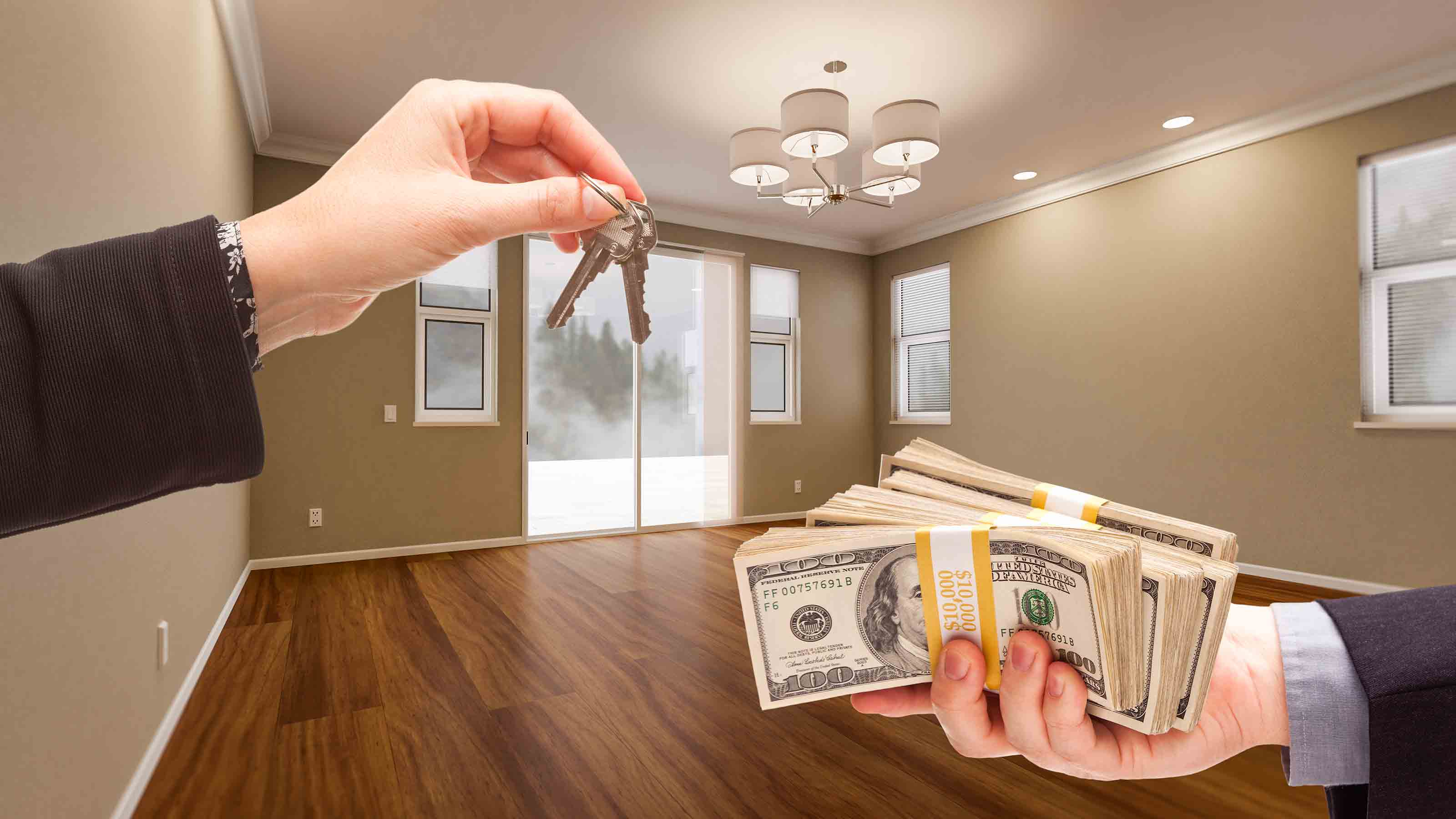What It Takes to Be a Landlord
A couple of pros share their hard-nosed approach to buying low and renting high.

The residence at 3809 Shannon Drive in northeast Baltimore has seen better days. Way better, to be honest. A two-story red-brick row house built in 1952, the 900-square-foot, three-bedroom unit has a tiny kitchen, rickety stairs, worn carpets, dingy and obsolete bathrooms, and, most off-putting, a concrete basement floor that curls up at either end in the shape of a half-pipe skateboard run. That's a sign of ominous settling and water damage. The nearest bus stop is a hike of four blocks. No supermarkets or restaurants are nearby. You're five miles from downtown. It feels like 25.
In a city rife with empty and deteriorating homes, no wonder the family of the elderly owner, who moved out last year to live with relatives, couldn't get their original asking price of $119,900 in February 2010. Nor could they attract a buyer when they lowered the price to $99,900 in May, or to $65,000 in October. Once they dropped the price to $55,000 in January 2011, professional real estate investors sensed an opportunity, like bottom-fishers snaring distressed stocks and bonds. So 3809 Shannon is getting a new lease on life.
The entrepreneur who bought it as-is in April for $42,000 is 45-year-old Baltimorean Fayz Khan, an automotive engineer turned full-time landlord. Khan thinks he can earn a return that would make Wall Street financiers envious. That's conceivable if Khan can recondition this pile of bricks quickly, at minimal cost, and get a reliable tenant who qualifies for a government rent subsidy. Khan thinks he can get $1,400 a month -- twice what plenty of nearby homeowners are paying each month on their mortgages, and about the same as the rent on a luxurious downtown condo. But that's what the federal government sets as "fair market rent" for a three-bedroom townhouse in Baltimore. Allowable rents are higher still in places like New York City and San Francisco.
From just $107.88 $24.99 for Kiplinger Personal Finance
Become a smarter, better informed investor. Subscribe from just $107.88 $24.99, plus get up to 4 Special Issues

Sign up for Kiplinger’s Free Newsletters
Profit and prosper with the best of expert advice on investing, taxes, retirement, personal finance and more - straight to your e-mail.
Profit and prosper with the best of expert advice - straight to your e-mail.
Going down-market
This deal highlights the essential truth of property investing today: To boost the odds that you'll make a profit, you need to go down-market, where the rents are exorbitant relative to the cost of ownership. This is due to a drastic shortage of decent low- and middle-income rentals. For many years, it paid to buy rental houses even if the monthly expenses exceeded the income because you could count on leverage, high appreciation and tax breaks to produce a profit in a few years. But that business model does not make sense in 2011. Property values are not appreciating, so you can't expect to buy a place and flip it for a fast return. You might be able to profit from a modest small apartment building or duplex, but overbuilt high-rise condos and foreclosed suburban homes aren't economically feasible as rentals. The idea now is to insist that every house or apartment deliver "positive cash flow" (a net monthly operating profit) with no exceptions. If a house cannot "cash flow," as the pros say, you need either to walk away from the deal or to offer so little that if by chance your bid is accepted, the numbers work.
Accomplishing that isn't as easy as buying cheap stocks. First, you have to come up with enough cash to launch your business with a couple of properties because banks have all but ceased lending to inexperienced landlords. Then, take a hard look at your handyman skills: If you can barely hang a light fixture, you're vulnerable to all kinds of unpleasant surprises. It also helps to know the local real estate market, local politics, and which neighborhoods are stable and which are in irreversible decline.
Shannon Drive is a tidy street in a neighborhood of homeowners with a strong community association, and bringing a property up to snuff could help preserve the area. But Peter Giardini, a veteran real estate investor whom Khan has hired to be his coach and adviser, has a tough litmus test for would-be landlords: "What if you were faced with evicting a family in the month of December? Could you do it? If you hesitate more than three seconds, I'd say you don't have the temperament for this business."
Based strictly on the numbers, however, veteran developer and old-house rehabber Jack BeVier, of Dominion Properties in Baltimore, says this is the time to strike. "The economics are some of the best I've ever seen for a sophisticated, professional landlord," he says. The wannabes who arrived late in the real estate bubble of the 2000s are gone, having lost their shirts, ruined their credit, crippled the banks and left tons of houses in foreclosure. The people who are now able to buy $120,000 houses for $42,000 are not complaining.
Positive cash flow
Giardini, who first invested in rentals ten years ago and has since sold all but three of his 80 units, used to reckon that $100 a month of positive cash flow was enough to justify an investment. Now, because real estate is riskier, he insists on $300. There are many formulas to calculate this. If rent minus all expenses, including a management fee and a reserve fund for vacancies, leaves more than $300, the transaction is a go. Tax deductions for depreciation don't figure here. They become icing on the cake after calculating overall earnings.
According to BeVier's analysis, the maximum total cost (price plus repairs and improvements) a landlord should put into a unit that rents for $600 to $1,000 a month is $30,000 to $50,000. If rental income from a wealthier tenant or one who is government-subsidized jumps to $1,000 to $1,500 a month, that justifies an investment of between $60,000 and $100,000 -- although the upper end would be a stretch. Another way to size up a property is to compute total costs -- purchase price, repairs, closing costs -- as a percentage of the house's appraised value. If the total comes to more than 60%, that's too much. In other words, the house must be worth more than $100,000 to justify an investment of $60,000.
As Khan hunts for properties to buy, he knows that his profit will depend on getting a low offer accepted. His resources include real estate agents and the ever-lengthening list of bank-owned properties, and he scopes out the neighborhoods where he already owns houses. He noticed 3809 Shannon months ago because he owns another house three blocks up the street. He toured the home when it was listed for $55,000 and got it for $42,000 largely by pointing to the warped basement floor (which could require costly reconstruction) and some cracks in the walls. An inspection report estimates that $6,800 of repairs and cleanup would be needed to bring the house to "minimum property standards" and another $26,500 to make it suitable for a permanent owner-occupant.
Khan will end up patching walls, cleaning baths, and installing no-frills replacement carpet at $11 per square yard. There's a landlord standard -- making a place suitable for renters -- and a homeowner standard -- fixing it up to sell as a primary residence. The two are tens of thousands of dollars apart in appearances and amenities. He figures it will cost him about $10,000 to prep the house for the building inspectors in time for tenant occupancy by June.
Khan is financing the purchase and repairs with a bank loan. Although credit is tight for newbies, he managed to get a line of credit at 7.75% because he owns eight other properties. He estimates that after all the financing costs and expenses, and based on a rent of $1,400, he'll clear a profit of $430 a month.
The tenants Khan hopes to attract qualify for Section 8 subsidies. Section 8 is the federal rent subsidy program for the working poor. Those who qualify typically hold secure but low-paying jobs, such as nurses' aides, school custodians, store clerks and the like. Section 8 tenants are screened by the Baltimore City housing authority, which funnels money from the feds to pay the majority of the rent directly to the landlord, with the tenant personally paying 30% of his or her income. The City of Baltimore's housing Web site lists all available Section 8 rentals. Prospective tenants can search the site and negotiate directly with property owners. Khan interviews and screens the tenants himself and thinks he already has one lined up for 3809. The trade-off is that standards for a house to qualify for Section 8 -- and for Khan to get that $1,400 rent -- are stricter than the typical local building code, and regular inspections are required.
A valuable way to learn what it means to be a landlord on a daily basis and what kinds of problems arise is through BiggerPockets.com, a real estate investor network, and the residential real estate and finance group at LinkedIn.com. For example, a common theme among landlords is that it's better to buy a vacant home and spruce it up because you can choose your tenants (subject to laws on nondiscrimination), run credit and criminal-history checks, and avoid potential eviction proceedings with existing tenants.
No landlord wants to be taken to housing court and possibly end up paying fines and legal fees. That means taking care of preventable problems -- repairing a heating system, for example -- before they flare up.
Tenacity and toughness
When Giardini met Khan at a real estate seminar, he decided the young engineer had what it takes to be a full-time real estate investor and took him on as a client. In Giardini's estimation, Khan is part of a small minority. "The gurus who say anyone can do this are liars," Giardini says.
As an adviser, Giardini teaches Khan the business, helps identify properties that won't cost an arm and a leg to bring up to rental snuff, and helps him crunch the numbers. Giardini, who is an engineer, a Navy submarine veteran and a financial analyst, can walk into a place and say, "Hey, this will cost $3,000 to fix." Or he can tell you to walk out in five minutes flat.
Giardini says prospective landlords shouldn't count on keeping a regular full-time job for long if they own more than about four rental properties. In 2000, at age 45, Giardini decided to quit a career in the defense-contracting industry and become either a full-time stock trader or a real estate investor. He chose real estate, but he kept his job while studying the business for a year before he and his wife and another couple bought their first rental property -- a group of ten units in eight buildings in 2001. He then resigned from his full-time job, only to face a contested eviction a few weeks later and a feeling of being overwhelmed by his new career.
As he learned more, he took advantage of the bull market in real estate and bankers' liberal credit practices of the early 2000s to accumulate 27 properties during his first year, most of them in Baltimore. He sold enough properties in 2006 to retire and move from Annapolis, Md., to central Maine, where he set up his practice as an adviser.
Khan now has nine properties and wants to buy three to five more each year. He has no plans to resume his career in engineering. With three small children and a wife who is a dentist, he says "freedom is the greatest benefit" of being a professional landlord. That freedom, however, isn't unlimited. Those stories you hear about being rousted out of bed at 3 a.m. to replace a shower head are urban legends. But landlords do have to tangle with complex financial analysis and negotiations with sellers. Investors who don't pass Giardini's toughness test are better off buying bonds or shares of a real estate investment trust.
Profit and prosper with the best of Kiplinger's advice on investing, taxes, retirement, personal finance and much more. Delivered daily. Enter your email in the box and click Sign Me Up.

Kosnett is the editor of Kiplinger Investing for Income and writes the "Cash in Hand" column for Kiplinger Personal Finance. He is an income-investing expert who covers bonds, real estate investment trusts, oil and gas income deals, dividend stocks and anything else that pays interest and dividends. He joined Kiplinger in 1981 after six years in newspapers, including the Baltimore Sun. He is a 1976 journalism graduate from the Medill School at Northwestern University and completed an executive program at the Carnegie-Mellon University business school in 1978.
-
 What Bilt Cardholders Need to Know as Wells Fargo Exits the Program
What Bilt Cardholders Need to Know as Wells Fargo Exits the ProgramA major shake-up in the Bilt Rewards program could affect your credit card, rent rewards and points strategy heading into 2026.
-
 3 Major Changes to the Charitable Deduction in 2026
3 Major Changes to the Charitable Deduction in 2026Tax Breaks About 144 million Americans might qualify for the 2026 universal charity deduction, while high earners face new IRS limits. Here's what to know.
-
 Where to Stash Cash as Yields Fall, According to Advisers
Where to Stash Cash as Yields Fall, According to AdvisersYour best options depend on how soon you'll need the money and your tolerance for risk.
-
 How to Search For Foreclosures Near You: Best Websites for Listings
How to Search For Foreclosures Near You: Best Websites for ListingsMaking Your Money Last Searching for a foreclosed home? These top-rated foreclosure websites — including free, paid and government options — can help you find listings near you.
-
 Luxury Home Prices Rise as the Rich Dodge High Mortgage Rates
Luxury Home Prices Rise as the Rich Dodge High Mortgage RatesLuxury home prices rose 9% to the highest third-quarter level on record, Redfin reports, growing nearly three times faster than non-luxury prices.
-
 Four Tips for Renting Out Your Home on Airbnb
Four Tips for Renting Out Your Home on Airbnbreal estate Here's what you should know before listing your home on Airbnb.
-
 Five Ways to Shop for a Low Mortgage Rate
Five Ways to Shop for a Low Mortgage RateBecoming a Homeowner Mortgage rates are high this year, but you can still find an affordable loan with these tips.
-
 Looking to Relocate? Plan for Climate Change
Looking to Relocate? Plan for Climate Changebuying a home Extreme weather events are on the rise. If you’re moving, make sure your new home is protected from climate change disasters.
-
 Retirees, A Healthy Condo Has a Flush Reserve Fund
Retirees, A Healthy Condo Has a Flush Reserve FundSmart Buying Reserve funds for a third of homeowner and condo associations have insufficient cash, experts say. Here are some cautionary steps you should take.
-
 Cash Home Buyers: New Services Offer Help Making All-Cash Offers
Cash Home Buyers: New Services Offer Help Making All-Cash OffersBecoming a Homeowner Some firms help home buyers make all-cash offers on homes. Weigh the fees before you sign on.
-
 Home Sale Prices in the 50 Largest Metro Areas
Home Sale Prices in the 50 Largest Metro AreasBecoming a Homeowner What’s happening in the market where you live?